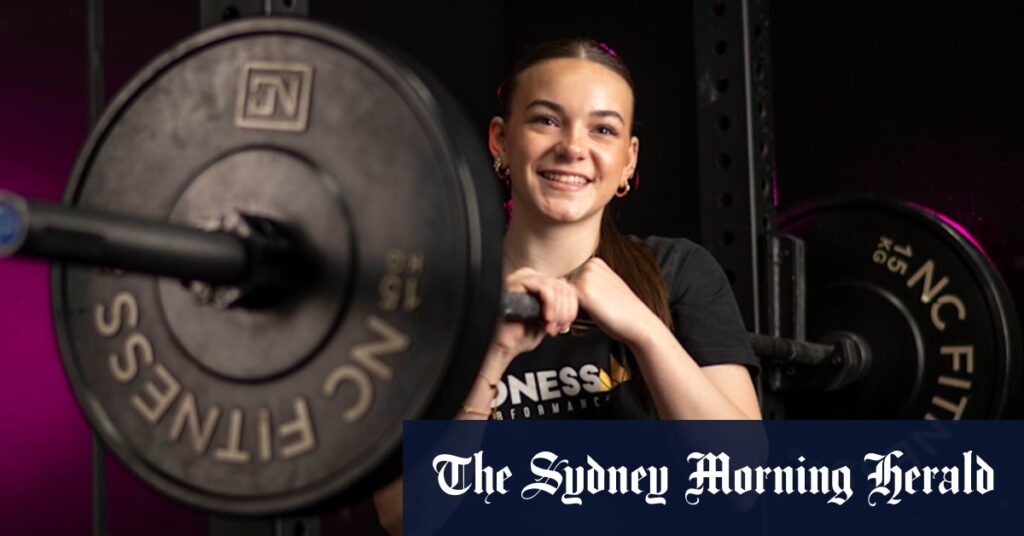
For many parents, convincing their teenagers to rise early for school is a daily challenge. However, for Melbourne’s Lara Jones, waking before dawn is a routine she embraces with enthusiasm. The 16-year-old competitive powerlifter starts her day at the gym, channeling her passion for fitness into a rigorous workout regime.
Four days a week, Lara hits the gym at 6:30 a.m. for a 55-minute session. Her routine includes a blend of stretches, activation exercises, weightlifting, and cardio, each tailored to specific areas of her body. As she prepares for the upcoming Hyrox competition in December, her training has evolved to incorporate elements of this indoor fitness challenge, which combines running with functional workout stations.
“Over the past month, my training has shifted slightly as I’ve begun preparing for a Hyrox competition,” Lara explains. “Before starting this new phase, my focus was entirely on powerlifting, where I trained four strength-based sessions per week.”
The Journey to Strength
Lara’s journey began at the age of 13 when she first visited Lioness Performance, her local gym. Inspired by the positive changes she observed in her mother and driven by her own desire to build strength, Lara quickly became captivated by the process.
“I fell in love with the process of lifting, setting goals, and pushing myself to improve,” she says. “It drove me to new levels of strength, both physically and mentally.”
Her dedication is part of a broader trend. According to the AUSPLAY sport participation survey and the National Health Survey by the ABS, “fitness/gym” activities rank highest among 15 to 17-year-olds in Australia, with a participation rate of about 30% in 2024. This consistency over the past decade highlights a growing interest in fitness among teens, whether through school programs, home workouts, or commercial gyms.
Guidelines and Safety in Teen Fitness
While there is no nationwide legislation in Australia setting a minimum age for gym access, guidelines such as those from the NSW Department of Tourism, Sport, and Recreation recommend supervision for anyone under 16. Dr. Jordan Smith from the University of Newcastle emphasizes the importance of these guidelines to ensure safety and proper technique.
“The negatives are usually due to a lack of adequate supervision and a program developed by appropriately qualified health and sports science professionals,” notes Dr. Loretta O’Sullivan-Pippia, a specialist sports and exercise physiotherapist.
For Lara, having her mother supervise her workouts and working with a trained coach has been crucial. “One aspect that both my coaches and I have always made a top priority in my training is the importance of bracing,” she says, highlighting its significance when lifting heavier weights.
Social Media’s Double-Edged Sword
While the physical benefits of exercise are clear, the psychological aspects are complex. Helen Bird from the Butterfly Foundation warns of the risks of body comparison and self-esteem issues that can arise in gym environments, exacerbated by social media.
“The gym environment can invite comparison and self-objectification, leading people to feel that they aren’t fit, strong, lean, or muscular enough,” Bird explains.
Dr. Smith concurs, noting the influence of social media on teen gym usage. “Appearance matters a lot to young people, and there is no shortage of fitness influencers online,” he says. This exposure can lead to both positive and negative outcomes, as seen in the experiences of teens like Salim Sarkis from Sydney.
Salim, who began working out at 15, acknowledges social media’s dual role. “On one hand, it can promote extreme behavior like bulking up, but on the other, it can encourage self-improvement,” he reflects. Initially motivated by a desire to improve his appearance, Salim now values the health benefits of his workouts.
Building a Community
Beyond physical and mental health benefits, both Lara and Salim have discovered an unexpected advantage: community. The gym has become a place where they connect with others who share their interests and goals.
“You gain that extra confidence when you see the results on your body physically, but most importantly, the mental health aspects of working out, that’s something I really, really appreciate,” Salim shares.
Experts like O’Sullivan-Pippia, Bird, and Smith agree that when approached correctly, exercise can significantly enhance teenagers’ health and well-being. As Lara prepares for her next competition, her story serves as a testament to the power of fitness to transform lives, fostering not only strength but also a sense of belonging.





